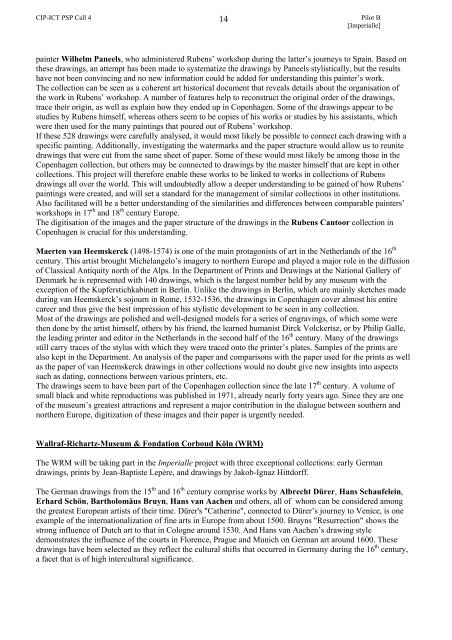proposal part b - The Bernstein Project
proposal part b - The Bernstein Project
proposal part b - The Bernstein Project
Create successful ePaper yourself
Turn your PDF publications into a flip-book with our unique Google optimized e-Paper software.
CIP-ICT PSP Call 4 14<br />
Pilot B<br />
[Imperialle]<br />
painter Wilhelm Paneels, who administered Rubens’ workshop during the latter’s journeys to Spain. Based on<br />
these drawings, an attempt has been made to systematize the drawings by Paneels stylistically, but the results<br />
have not been convincing and no new information could be added for understanding this painter’s work.<br />
<strong>The</strong> collection can be seen as a coherent art historical document that reveals details about the organisation of<br />
the work in Rubens’ workshop. A number of features help to reconstruct the original order of the drawings,<br />
trace their origin, as well as explain how they ended up in Copenhagen. Some of the drawings appear to be<br />
studies by Rubens himself, whereas others seem to be copies of his works or studies by his assistants, which<br />
were then used for the many paintings that poured out of Rubens’ workshop.<br />
If these 528 drawings were carefully analysed, it would most likely be possible to connect each drawing with a<br />
specific painting. Additionally, investigating the watermarks and the paper structure would allow us to reunite<br />
drawings that were cut from the same sheet of paper. Some of these would most likely be among those in the<br />
Copenhagen collection, but others may be connected to drawings by the master himself that are kept in other<br />
collections. This project will therefore enable these works to be linked to works in collections of Rubens<br />
drawings all over the world. This will undoubtedly allow a deeper understanding to be gained of how Rubens’<br />
paintings were created, and will set a standard for the management of similar collections in other institutions.<br />
Also facilitated will be a better understanding of the similarities and differences between comparable painters’<br />
workshops in 17 th and 18 th century Europe.<br />
<strong>The</strong> digitisation of the images and the paper structure of the drawings in the Rubens Cantoor collection in<br />
Copenhagen is crucial for this understanding.<br />
Maerten van Heemskerck (1498-1574) is one of the main protagonists of art in the Netherlands of the 16 th<br />
century. This artist brought Michelangelo’s imagery to northern Europe and played a major role in the diffusion<br />
of Classical Antiquity north of the Alps. In the De<strong>part</strong>ment of Prints and Drawings at the National Gallery of<br />
Denmark he is represented with 140 drawings, which is the largest number held by any museum with the<br />
exception of the Kupferstichkabinett in Berlin. Unlike the drawings in Berlin, which are mainly sketches made<br />
during van Heemskerck’s sojourn in Rome, 1532-1536, the drawings in Copenhagen cover almost his entire<br />
career and thus give the best impression of his stylistic development to be seen in any collection.<br />
Most of the drawings are polished and well-designed models for a series of engravings, of which some were<br />
then done by the artist himself, others by his friend, the learned humanist Dirck Volckertsz, or by Philip Galle,<br />
the leading printer and editor in the Netherlands in the second half of the 16 th century. Many of the drawings<br />
still carry traces of the stylus with which they were traced onto the printer’s plates. Samples of the prints are<br />
also kept in the De<strong>part</strong>ment. An analysis of the paper and comparisons with the paper used for the prints as well<br />
as the paper of van Heemskerck drawings in other collections would no doubt give new insights into aspects<br />
such as dating, connections between various printers, etc.<br />
<strong>The</strong> drawings seem to have been <strong>part</strong> of the Copenhagen collection since the late 17 th century. A volume of<br />
small black and white reproductions was published in 1971, already nearly forty years ago. Since they are one<br />
of the museum’s greatest attractions and represent a major contribution in the dialogue between southern and<br />
northern Europe, digitization of these images and their paper is urgently needed.<br />
Wallraf-Richartz-Museum & Fondation Corboud Köln (WRM)<br />
<strong>The</strong> WRM will be taking <strong>part</strong> in the Imperialle project with three exceptional collections: early German<br />
drawings, prints by Jean-Baptiste Lepère, and drawings by Jakob-Ignaz Hittdorff.<br />
<strong>The</strong> German drawings from the 15 th and 16 th century comprise works by Albrecht Dürer, Hans Schaufelein,<br />
Erhard Schön, Bartholomäus Bruyn, Hans van Aachen and others, all of whom can be considered among<br />
the greatest European artists of their time. Dürer's "Catherine", connected to Dürer’s journey to Venice, is one<br />
example of the internationalization of fine arts in Europe from about 1500. Bruyns "Resurrection" shows the<br />
strong influence of Dutch art to that in Cologne around 1530. And Hans van Aachen’s drawing style<br />
demonstrates the influence of the courts in Florence, Prague and Munich on German art around 1600. <strong>The</strong>se<br />
drawings have been selected as they reflect the cultural shifts that occurred in Germany during the 16 th century,<br />
a facet that is of high intercultural significance.









